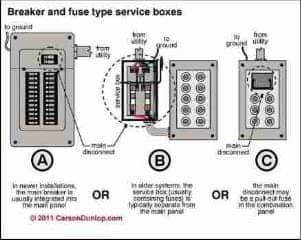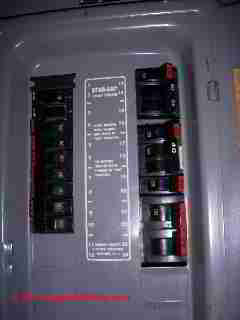 How to Inspect the Size of the Main Electrical Disconnect, Fuse, or Breaker
How to Inspect the Size of the Main Electrical Disconnect, Fuse, or Breaker
- POST a QUESTION or COMMENT about how to inspect the main electrical disconnect switch or fuse
Electrical Service Main Disconnect or Main Breaker: This article explains how to estimate the electrical service size, (or "electrical power" or "service amps") at a building by visual examination of the main electrical service disconnect switch, and related details.
In this article series on determining the ampacity and voltage provided by different residential electrical equipment, we also include photographs and sketches illustrate electrical panels, meter bases, and electric meters.
InspectAPedia tolerates no conflicts of interest. We have no relationship with advertisers, products, or services discussed at this website.
- Daniel Friedman, Publisher/Editor/Author - See WHO ARE WE?
How to find the Main electrical service disconnect ampacity
In determining the service amperage at a property a key component to examine is the main disconnect switch such as we illustrate at page top and at left, thanks to Carson Dunlop Associates ' sketch.
We look for an amperage indication right on the main disconnect switch. If no markings are present, document that observation.
Markings in or on the panel box about ampacity indicate what current limiting device (such as a fuse) size could or should be installed, not what fuse or breaker size is actually present.
[Click to enlarge any image]
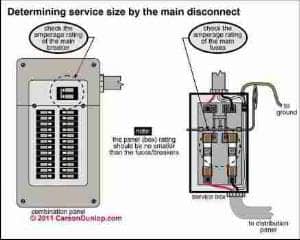
Look at the main electrical disconnect switch fuse/breaker for this ampacity number.
Beware: I [DF] have found buildings with mismatched SEC and main panel switch, with errors in both directions: in one instance a new 100A SEC was installed but connected to an old 60A service panel (safe but not delivering 100A to the building).
In a second case, a new 150A panel was installed but connected to an old 60A SEC (unsafe)
Split Bus Electrical Panels: Multiple Main Disconnects
Watch Out: some electrical panels, especially models using a split-bus design may not have a single main disconnect switch in the panel. There may be multiple "main" disconnects in the panel, usually grouped together.
Our Federal Pacific Electric panel (photo at left) appears to be one of these models [click to see an enlarged detailed view of this panel]. By its internal label (not shown) this panel was rated for 200 Amps.
Several of these switches may power individual high-ampacity electrical circuits in the building (air conditioner, electric range, electric water heater, for example) and one will power the lower bus in the panel to which branch circuits are wired for lighting and electrical receptacles.
Also check for a separate individual main disconnect switch between the panel and the electric meter.
Details are at SPLIT BUS ELECTRICAL PANEL HAZARDS
See more split bus panels
at FRANK ADAM ELECTRICAL PANELS
Also see FEDERAL PACIFIC FPE HAZARDS
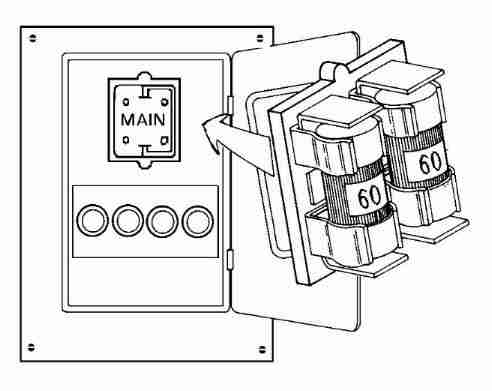
On some fuse systems the main fuses, usually a cartridge type, may be visible and the fuse ratings may be read on the fuse itself. [Figure at left] There are varying opinions among inspectors about pulling out a fuse block to read a hidden fuse value.
Home inspection educator and writer Mark Cramer reminds us that you can usually see the color of the fuse through the little hole. Also note that you generally can't put a fuse that's too large into a block. For example, you can't put a 150 amp fuse in a 60 amp block.
However I have seen smaller fuses inserted in larger-fuse blocks using an adapter, and I've seen copper tubing and copper pipe inserted where a fuse belonged!
So if you can't see the fuse, it's risky to assume the right thing is in place. In Canadian and in some US panels fuses can be changed individually and may be more visible.
In an occupied building we do not pull a fuse or shut off any component without permission.
While these devices are designed to be pulled by the homeowner and thus fall under ASHI's definition of "normal user or operator controls," we've seen and had reports of accidents including broken fuse pullout blocks, arcing, loss of power, and angry owners whose computers or kidney dialysis machines were in operation.
And if we find a horrible rusty fuse or breaker panel such as the fuse panel shown at left, we would be reluctant to handle it - this equipment is unsafe and likely to be easily pushed "over the edge" into collapse simply by touching it.
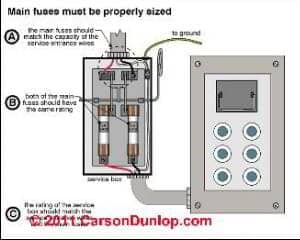
We do pull fuses in unoccupied buildings and may pull fuses in an occupied building with permission, provided in both cases our visual inspection of the equipment does not reveal any obvious unsafe condition.
On the occasion when we pulled a fuse which disintegrated all parties agreed that it was better to discover the need for that repair now than in an emergency when power was needed.
If you find a fuse smaller than the maximum permitted by the conductors and panel equipment you should inform your client. But this is not a defect any more than it is unsafe to screw an 60-watt light bulb into a light designed to permit 100 watt bulbs.
Watch out: the opposite is not OK - a fuse that is rated at larger capacity than permitted for the wire size, such as a 30Amp fuse on a #14 wire branch circuit, would be unsafe. #14 copper wire is rated for a 15-Amp circuit and should be protected by a 15-Amp fuse or circuit breaker.
If you cannot see the actual fuse, you may be able to see a rating on the fuse holder itself. However be warned that there are methods (not recommended) for modifying fuse holders to carry fuses other than those intended. You may even find pieces of copper pipe used as "jumpers" to replace the original fuses. These modifications are unsafe. If you do not pull the fuse and cannot see the ampacity, report this limitation to your client.
...
Continue reading at SE CABLE & BRANCH CIRCUIT WIRE SIZES vs AMPS or select a topic from the closely-related articles below, or see the complete ARTICLE INDEX.
Or see these
Recommended Articles
- BLOWN FUSE REPLACEMENT
- ELECTRICAL INSPECTOR SAFETY PROCEDURES important basic safety procedures, clothing, and equipment for home inspectors and electrical inspectors.
- MAIN ELECTRICAL DISCONNECT
- SAFETY HAZARDS & SAFE ELECTRICAL INSPECTION PROCEDURES for examining Residential Electrical Panels.
Suggested citation for this web page
MAIN DISCONNECT AMPACITY at InspectApedia.com - online encyclopedia of building & environmental inspection, testing, diagnosis, repair, & problem prevention advice.
Or see this
INDEX to RELATED ARTICLES: ARTICLE INDEX to ELECTRICAL INSPECTION & TESTING
Or use the SEARCH BOX found below to Ask a Question or Search InspectApedia
Ask a Question or Search InspectApedia
Questions & answers or comments about how to inspect the main electrical disconnect switch or fuse.
Try the search box just below, or if you prefer, post a question or comment in the Comments box below and we will respond promptly.
Search the InspectApedia website
Note: appearance of your Comment below may be delayed: if your comment contains an image, photograph, web link, or text that looks to the software as if it might be a web link, your posting will appear after it has been approved by a moderator. Apologies for the delay.
Only one image can be added per comment but you can post as many comments, and therefore images, as you like.
You will not receive a notification when a response to your question has been posted.
Please bookmark this page to make it easy for you to check back for our response.
IF above you see "Comment Form is loading comments..." then COMMENT BOX - countable.ca / bawkbox.com IS NOT WORKING.
In any case you are welcome to send an email directly to us at InspectApedia.com at editor@inspectApedia.com
We'll reply to you directly. Please help us help you by noting, in your email, the URL of the InspectApedia page where you wanted to comment.
Citations & References
In addition to any citations in the article above, a full list is available on request.
- The Original Authors: Alan Carson is an ASHI Member, national home inspection educator, author and building failures researcher in Toronto, Ontario. Daniel Friedman, an original author of this article and the editor and producer of InspectAPedia where this article now appears is an ASHI Member, first ASHI Technical Committee chairman, editor and publisher of the ASHI Technical Journal, licensed home inspector, educator, and building failures researcher in Poughkeepsie, NY. Robert Klewitz is a licensed professional engineer, a professional home inspector, an ASHI Member, and has served on the ASHI Technical Committee as well as in other ASHI activities. His practice is in Issaquah, WA.
- ASHI Technical Journal, Vol. 2. No. 1, January 1992, "Determining Service Ampacity," Dan Friedman and Alan Carson, and the
- ASHI Technical Journal, Vol. 3. No. 1, Spring, 1993, "Determining Service Ampacity - Another Consideration," Robert L. Klewitz, P.E., with subsequent updates and additions to the original text ongoing to 2/19/2006. Reprints of the originals and reprints of the Journal are available from ASHI, the American Society of Home Inspectors www.ashi.com.
- Mark Cramer Inspection Services Mark Cramer, Tampa Florida, Mr. Cramer is a past president of ASHI, the American Society of Home Inspectors and is a Florida home inspector and home inspection educator. Contact Mark Cramer at: 727-595-4211 mark@BestTampaInspector.com 11/06
- Douglas Hansen, Robert Stead. Mark Cramer. Photographs: Daniel Friedman.
- N. Srinivasan, MSEE, is a senior member of IEEE with 30 years experience in the electrical industry. Mr. Srinivasan is in Vienna VA.
- Louis P. Babin generously contributed technical editing about the effects of doubling ampacity in an electrical circuit (September 2007)
- "Electrical System Inspection Basics," Richard C. Wolcott, ASHI 8th Annual Education Conference, Boston 1985.
- "Simplified Electrical Wiring," Sears, Roebuck and Co., 15705 (F5428) Rev. 4-77 1977 [Lots of sketches of older-type service panels.]
- "How to plan and install electric wiring for homes, farms, garages, shops," Montgomery Ward Co., 83-850.
- "Simplified Electrical Wiring," Sears, Roebuck and Co., 15705 (F5428) Rev. 4-77 1977 [Lots of sketches of older-type service panels.]
- "Home Wiring Inspection," Roswell W. Ard, Rodale's New Shelter, July/August, 1985 p. 35-40.
- "Evaluating Wiring in Older Minnesota Homes," Agricultural Extension Service, University of Minnesota, St. Paul, Minnesota 55108.
- "Electrical Systems," A Training Manual for Home Inspectors, Alfred L. Alk, American Society of Home Inspectors (ASHI), 1987, available from ASHI. [DF NOTE: I do NOT recommend this obsolete publication, though it was cited in the original Journal article as it contains unsafe inaccuracies]
- "Basic Housing Inspection," US DHEW, S352.75 U48, p.144, out of print, but is available in most state libraries.
- In addition to citations & references found in this article, see the research citations given at the end of the related articles found at our suggested
CONTINUE READING or RECOMMENDED ARTICLES.
- Carson, Dunlop & Associates Ltd., 120 Carlton Street Suite 407, Toronto ON M5A 4K2. Tel: (416) 964-9415 1-800-268-7070 Email: info@carsondunlop.com. Alan Carson is a past president of ASHI, the American Society of Home Inspectors.
Thanks to Alan Carson and Bob Dunlop, for permission for InspectAPedia to use text excerpts from The HOME REFERENCE BOOK - the Encyclopedia of Homes and to use illustrations from The ILLUSTRATED HOME .
Carson Dunlop Associates provides extensive home inspection education and report writing material. In gratitude we provide links to tsome Carson Dunlop Associates products and services.


